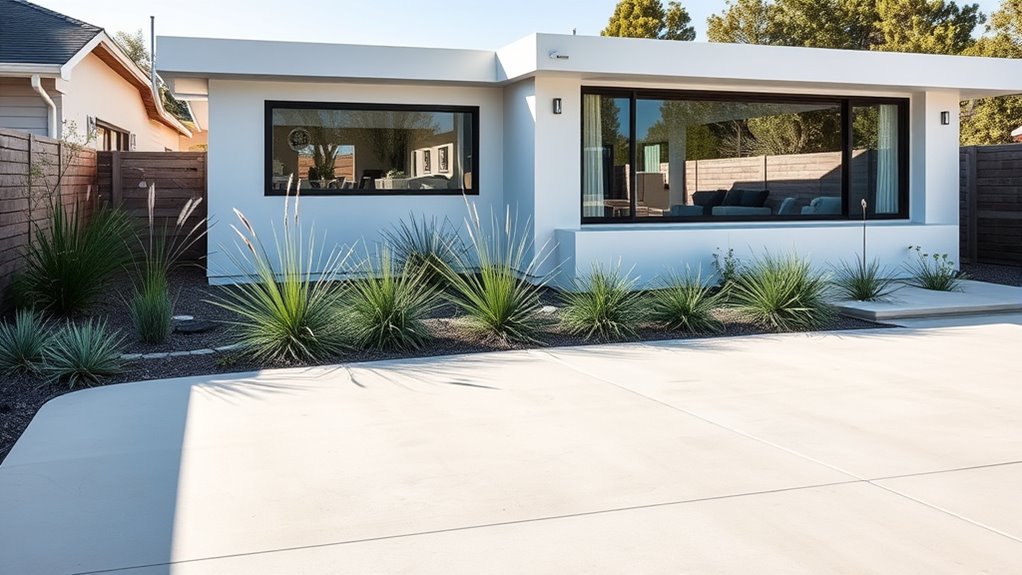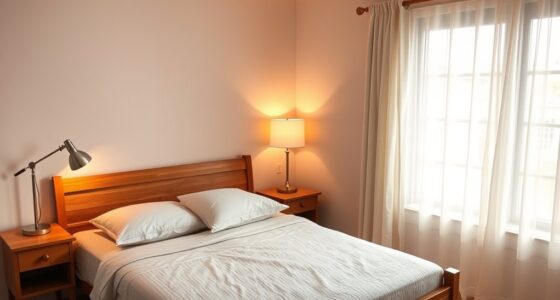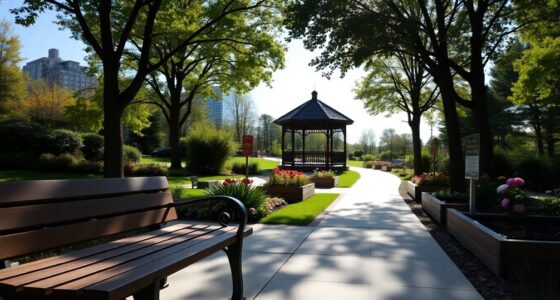To minimize upkeep, choose low-maintenance plants like succulents and native grasses, and opt for durable materials such as stone, concrete, or treated wood for outdoor features. Inside, select surfaces like quartz or sealed hardwood that resist stains and scratches. Use simple window coverings, incorporate built-in storage, and embrace minimalist design to reduce clutter. Installing motion-sensor lighting and smart storage solutions helps streamline maintenance. Keep your space effortlessly organized—continue exploring ways to make your home truly low-maintenance.
Key Takeaways
- Choose drought-tolerant, native plants and durable outdoor materials to reduce watering and maintenance efforts.
- Opt for easy-to-clean surfaces like quartz countertops, tile flooring, and sealed hardwood throughout the home.
- Install automated lighting and built-in storage to enhance convenience and minimize clutter.
- Incorporate minimalist design principles and vertical storage to simplify cleaning and organization.
- Regularly assess and rotate landscape elements to prevent clutter and ensure lasting visual harmony.

Are you looking to refresh your living space but unsure where to start? One effective way to achieve a low-maintenance home is by focusing on smart design choices that reduce ongoing effort and costs. When it comes to outdoor spaces, garden landscaping can greatly enhance your yard’s appearance without demanding constant attention. Opt for low-maintenance plants that thrive with minimal care, such as succulents, native grasses, or hardy shrubs. These plants are resilient and require less watering, pruning, and fertilizing. To further cut down on upkeep, incorporate durable materials in your landscaping features. Use stone, concrete, or treated wood for pathways, patios, and edging—these materials resist weathering and damage over time, meaning you won’t need frequent repairs or replacements. This approach not only saves you money but also keeps your outdoor area looking polished with less effort. Regularly assessing and rotating your landscape elements can also help prevent clutter buildup and maintain visual harmony.
Inside your home, prioritize design elements that are easy to clean and maintain. Choose surfaces like quartz countertops, tile flooring, or sealed hardwood that resist stains and scratches. These materials stand up well to daily wear and tear, so you don’t have to worry about constant refinishing or deep cleaning. Keep clutter to a minimum by selecting furniture pieces that are both stylish and functional, with easy-to-wipe surfaces or removable cushions. Minimalist designs tend to be easier to keep tidy, freeing you from the time-consuming chore of maintaining intricate decor or excessive accessories. Incorporating vertical storage solutions can further streamline your space and reduce clutter.
Lighting is another aspect that can reduce your home’s upkeep. Install automated or motion-sensor lights that turn on when needed, eliminating the hassle of manual switches. This not only conserves energy but also reduces the effort required to keep your home secure and well-lit. Consider built-in storage solutions to hide away clutter, making your space appear neat without the constant effort of organizing. When selecting window coverings, opt for blinds or shades that are simple to operate and clean, avoiding heavy drapes that collect dust and require frequent washing.
Frequently Asked Questions
What Materials Are Best for Low-Maintenance Flooring?
When choosing flooring, opt for materials with durable finishes and stain-resistant surfaces, making maintenance easier. Vinyl and laminate are top choices because they resist scratches and spills, saving you time and effort. Porcelain or ceramic tiles are also low-maintenance, as they’re durable and simple to clean. Avoid high-maintenance options like hardwood, which require frequent refinishing. With these materials, your floors stay beautiful with minimal upkeep, giving you more time to enjoy your home.
How Can I Reduce Outdoor Yard Work?
Think of your yard as a garden that needs less watering. To cut down on outdoor work, consider landscape xeriscaping with drought-tolerant plants, which thrive with minimal care. You can also swap out real grass for artificial turf, eliminating mowing and watering. These changes turn yard maintenance into a breeze, saving you time and effort while keeping your outdoor space beautiful and functional with less work on your part.
What Are Low-Maintenance Options for Kitchen Countertops?
You want low-maintenance kitchen countertops? Consider granite or quartz surfaces—they’re durable and easy to clean, saving you time and effort. Granite countertops resist stains when sealed properly, while quartz surfaces are non-porous and require minimal upkeep. Both options withstand daily use, so you won’t have to worry about frequent repairs or special cleaning routines. These surfaces help you enjoy a beautiful kitchen without the constant upkeep.
How Can I Design a Low-Maintenance Garden?
To design a low-maintenance garden, you should choose native plants that thrive in your climate and require less water and care. Incorporate an automated irrigation system to guarantee consistent watering without extra effort. Group plants with similar needs, use mulch to reduce weeds, and select drought-tolerant varieties. This approach minimizes upkeep, keeps your garden vibrant, and allows you to enjoy your outdoor space effortlessly.
What Features Help Minimize Bathroom Cleaning Time?
You can minimize bathroom cleaning time by choosing self-cleaning fixtures, which reduce grime buildup and make wiping easier. Opt for water-resistant paint on walls and ceilings; it prevents mold and mildew, cutting down on scrubbing. Installing smooth, grout-free surfaces like large tiles or acrylic panels also simplifies cleaning. These features work together to keep your bathroom looking fresh with minimal effort, saving you time and hassle.
Conclusion
By choosing low-maintenance materials and simple layouts, you create a home that’s easy to care for, allowing your space to stay fresh and inviting. Yet, this simplicity doesn’t mean sacrificing style or comfort; instead, it offers a peaceful refuge from constant upkeep. Embrace the balance between practicality and beauty, knowing that smart design choices can free up your time while still reflecting your personality. Ultimately, thoughtful minimalism becomes both a sanctuary and a statement.









